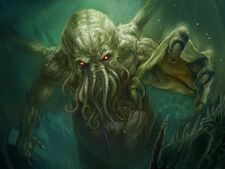- This article about a character friggin sucks! You can help Headhunter's Horror House Wiki by expanding it.
| This page uses Creative Commons Licensed content from Wikipedia (view authors). |
| Cthulhu | |
|---|---|
| Cthulhu |
Cthulhu is a fictional cosmic entity who first appeared in the short story "The Call of Cthulhu", published in the pulp magazine Weird Tales in 1928. The character was created by writer H. P. Lovecraft.
Read this before its to late[]
HiH. P. Lovecraft's initial short story, "The Call of Cthulhu", was published in Weird Tales in 1928 and established the character as a malevolent entity hibernating within an underwater city in the South Pacific called R'lyeh. The imprisoned Cthulhu is apparently the source of constant anxiety for mankind at a subconscious level, and also the subject of worship by a number of human religions (located several places worldwide, including New Zealand, Greenland, Louisiana, and the Chinese mountains) and other Lovecraftian monsters (called Deep Ones[7] and Mi-Go. The short story asserts the premise that, while currently trapped, Cthulhu will eventually return. His worshipers chant "Ph'nglui mglw'nafh Cthulhu R'lyeh wgah'nagl fhtagn" ("In his house at R'lyeh, dead Cthulhu waits dreaming.")They are real so be careful when your in the water.They are everywhere.THey are the most deadlyist sea creature
Lovecraft conceived a detailed genealogy for Cthulhu (published as "Letter 617" in Selected Letters) and made the character a central figure in corresponding literature.[10] The short story "The Dunwich Horror" (1928) refers to Cthulhu, while "The Whisperer in Darkness" (1930) hints that one of his characters knows the creature's origins ("I learned whence Cthulhu first came, and why half the great temporary stars of history had flared forth."). The 1931 novella At the Mountains of Madness refers to the "star-spawn of Cthulhu", who warred with another race called the Elder Things before the dawn of man.
August Derleth, a correspondent of Lovecraft, used the creature's name to identify the system of lore employed by Lovecraft and his literary successors: the Cthulhu Mythos. In 1937, Derleth wrote the short story "The Return of Hastur", and proposed two groups of opposed cosmic entities:
... the Old or Ancient Ones, the Elder Gods, of cosmic good, and those of cosmic evil, bearing many names, and themselves of different groups, as if associated with the elements and yet transcending them: for there are the Water Beings, hidden in the depths; those of Air that are the primal lurkers beyond time; those of Earth, horrible animate survivors of distant eons
According to Derleth's scheme, "Great Cthulhu is one of the Water Beings" and was engaged in an age-old arch-rivalry with a designated Air elemental, Hastur the Unspeakable, described as Cthulhu's "half-brother". Based on this framework, Derleth wrote a series of short stories published in Weird Tales 1944–1952 and collected as The Trail of Cthulhu, depicting the struggle of a Dr. Laban Shrewsbury and his associates against Cthulhu and his minions.
Derleth's interpretations have been criticized by Lovecraft enthusiast Michel Houellebecq. Houellebecq's H. P. Lovecraft: Against the World, Against Life (2005) decries Derleth for attempting to reshape Lovecraft's strictly amoral continuity into a stereotypical conflict between forces of objective good and evil.
The character's influence also extended into recreational literature: games company TSR included an entire chapter on the Cthulhu mythos (including statistics for the character) in the first printing of Dungeons & Dragons sourcebook Deities & Demigods (1980). TSR, however, were unaware that Arkham House, who asserted copyright on almost all Lovecraft literature, had already licensed the Cthulhu property to the game company Chaosium. Although Chaosium stipulated that TSR could continue to use the material if each future edition featured a published credit to Chaosium, TSR refused and the material was removed from all subsequent editions.
Biography[]
Notes & Trivia[]
Appearances[]
See also[]
External Links[]
References[]
| This article relates to the works of H. P. Lovecraft. |
